The microtubule-associated protein tumor overexpressed gene/cytoskeleton-associated protein 5 is necessary for myelin basic protein expression in oligodendrocytes
- PMID: 17634360
- PMCID: PMC6672871
- DOI: 10.1523/JNEUROSCI.0203-07.2007
The microtubule-associated protein tumor overexpressed gene/cytoskeleton-associated protein 5 is necessary for myelin basic protein expression in oligodendrocytes
Abstract
Tumor overexpressed gene (TOG) protein, encoded by cytoskeleton-associated protein CKAP5, is a microtubule-associated protein that binds to heterogeneous nuclear ribonucleoprotein (hnRNP) A2. hnRNP A2 is an RNA trafficking factor that associates with myelin basic protein (MBP) mRNA. In oligodendrocytes, TOG, hnRNP A2, and MBP mRNA colocalize in granules that assemble in the perikaryon and are transported to the peripheral network of processes that extends from it. MBP accumulates preferentially in the membrane of the medial and distal portions of these cellular processes. MBP expression was reduced when TOG level was lowered by short-hairpin (sh) RNA. The reduction in TOG did not affect overall cell morphology or the assembly, transport, localization, or number of MBP mRNA-containing granules. Reduced levels of TOG did not affect another oligodendrocyte-specific component, myelin oligodendrocyte glycoprotein, which is expressed at the same time as MBP but translated from mRNA localized in the cell body. Expression in a neural cell line of a green fluorescent protein (GFP)-MBP fusion protein derived from a construct containing GFP and the full-length cDNA for the rat 14 kDa MBP was reduced when TOG level was lowered by shRNA treatment. Expression of GFP, derived from GFP mRNA containing the hnRNP A2 binding element of MBP mRNA, was similarly reduced in cells with low TOG levels. These data indicate that TOG is necessary for efficient translation of MBP mRNA and suggest that this role is mediated by its interaction with hnRNP A2.
Figures
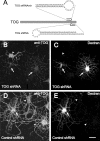
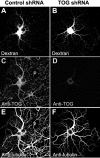


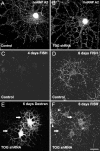
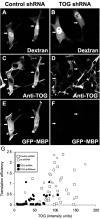
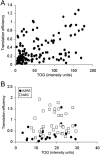
Similar articles
-
The microtubule-associated protein tumor overexpressed gene binds to the RNA trafficking protein heterogeneous nuclear ribonucleoprotein A2.Mol Biol Cell. 2005 Apr;16(4):1938-47. doi: 10.1091/mbc.e04-08-0709. Epub 2005 Feb 9. Mol Biol Cell. 2005. PMID: 15703215 Free PMC article.
-
Heterogeneous nuclear ribonucleoprotein (hnRNP) F is a novel component of oligodendroglial RNA transport granules contributing to regulation of myelin basic protein (MBP) synthesis.J Biol Chem. 2012 Jan 13;287(3):1742-54. doi: 10.1074/jbc.M111.235010. Epub 2011 Nov 29. J Biol Chem. 2012. PMID: 22128153 Free PMC article.
-
Transport and translation of MBP mRNA is regulated differently by distinct hnRNP proteins.J Cell Sci. 2014 Apr 1;127(Pt 7):1550-64. doi: 10.1242/jcs.140855. Epub 2014 Feb 12. J Cell Sci. 2014. PMID: 24522184
-
RNA trafficking in oligodendrocytes.Results Probl Cell Differ. 2001;34:69-81. doi: 10.1007/978-3-540-40025-7_5. Results Probl Cell Differ. 2001. PMID: 11288680 Review.
-
Rules of engagement promote polarity in RNA trafficking.BMC Neurosci. 2006 Oct 30;7 Suppl 1(Suppl 1):S3. doi: 10.1186/1471-2202-7-S1-S3. BMC Neurosci. 2006. PMID: 17118157 Free PMC article. Review.
Cited by
-
Changes in protein expression of pacific oyster Crassostrea gigas exposed in situ to urban sewage.Environ Sci Pollut Res Int. 2015 Nov;22(22):17267-79. doi: 10.1007/s11356-014-3821-8. Epub 2014 Nov 16. Environ Sci Pollut Res Int. 2015. PMID: 25398216
-
Tyrosine phosphorylation regulates hnRNPA2 granule protein partitioning and reduces neurodegeneration.EMBO J. 2021 Feb 1;40(3):e105001. doi: 10.15252/embj.2020105001. Epub 2020 Dec 22. EMBO J. 2021. PMID: 33349959 Free PMC article.
-
Conditional knockout of TOG results in CNS hypomyelination.Glia. 2017 Mar;65(3):489-501. doi: 10.1002/glia.23106. Epub 2017 Jan 7. Glia. 2017. PMID: 28063167 Free PMC article.
-
Signaling from the secretory granule to the nucleus: Uhmk1 and PAM.Mol Endocrinol. 2010 Aug;24(8):1543-58. doi: 10.1210/me.2009-0381. Epub 2010 Jun 23. Mol Endocrinol. 2010. PMID: 20573687 Free PMC article.
-
Making myelin basic protein -from mRNA transport to localized translation.Front Cell Neurosci. 2013 Sep 27;7:169. doi: 10.3389/fncel.2013.00169. Front Cell Neurosci. 2013. PMID: 24098271 Free PMC article. Review.
References
-
- Akhmanova A, Hoogenraad C. Microtubule plus-end-tracking proteins: mechanisms and functions. Curr Opin Cell Biol. 2005;17:47–54. - PubMed
-
- Amur-Umarjee S, Schonmann V, Campagnoni A. Neuronal regulation of myelin basic protein mRNA translocation in oligodendrocytes is mediated by platelet-derived growth factor. Dev Neurosci. 1997;19:143–151. - PubMed
-
- Barbarese E, Brumwell C, Kwon S, Cui H, Carson J. RNA on the road to myelin. J Neurocytol. 1999;28:263–270. - PubMed
-
- Browne G, Proud C. Regulation of peptide-chain elongation in mammalian cells. Eur J Biochem. 2002;269:5360–5368. - PubMed
Publication types
MeSH terms
Substances
Grants and funding
LinkOut - more resources
Full Text Sources
Other Literature Sources
Miscellaneous
